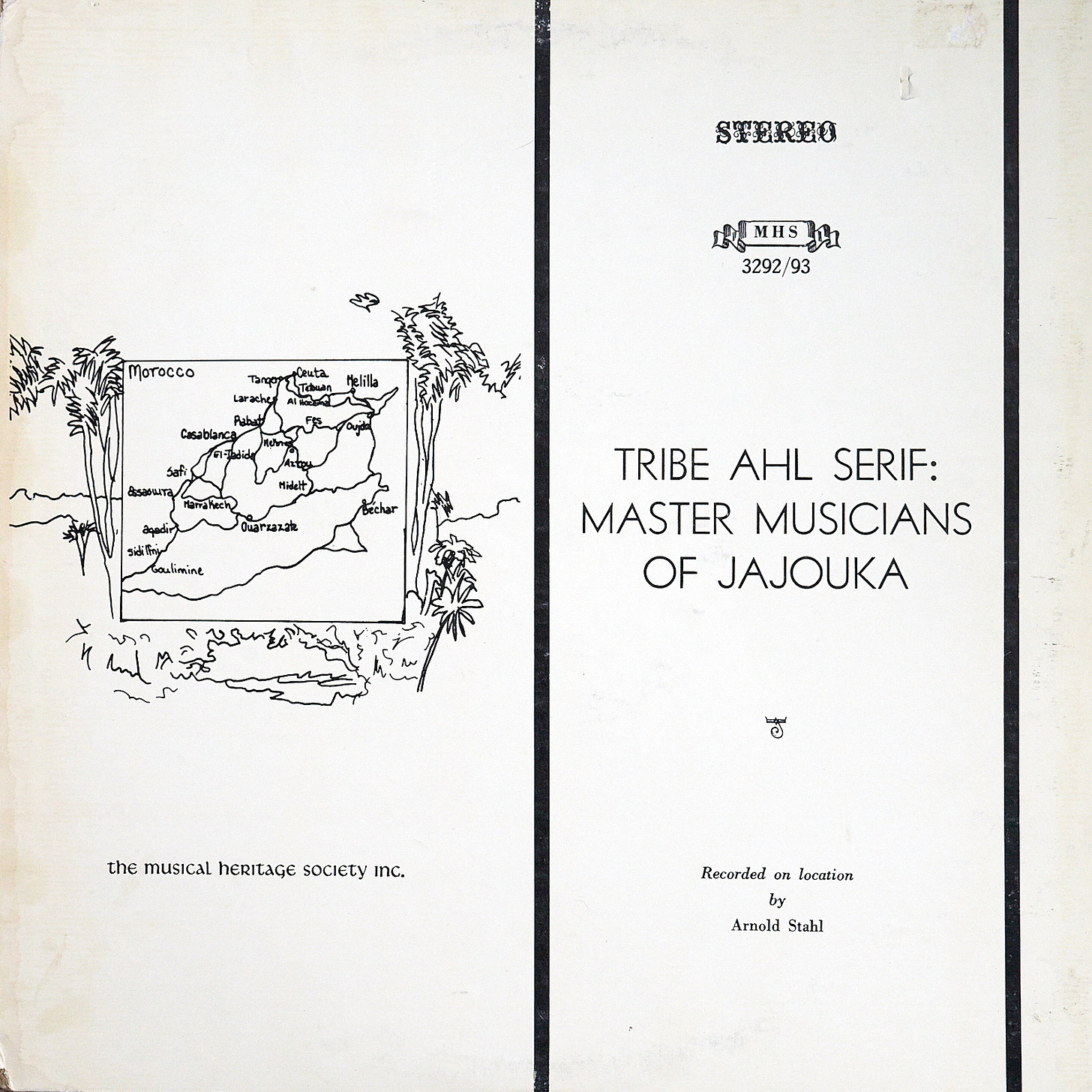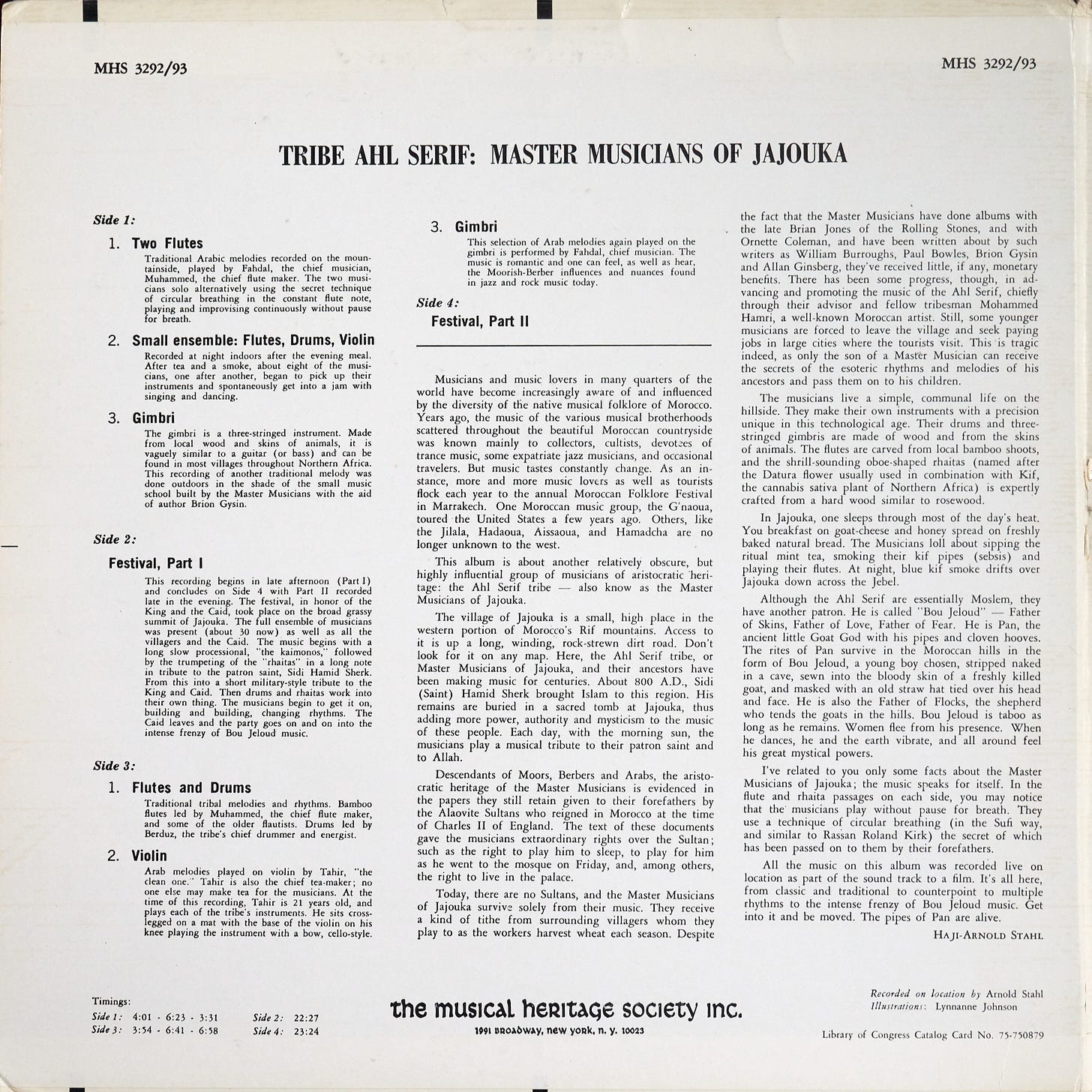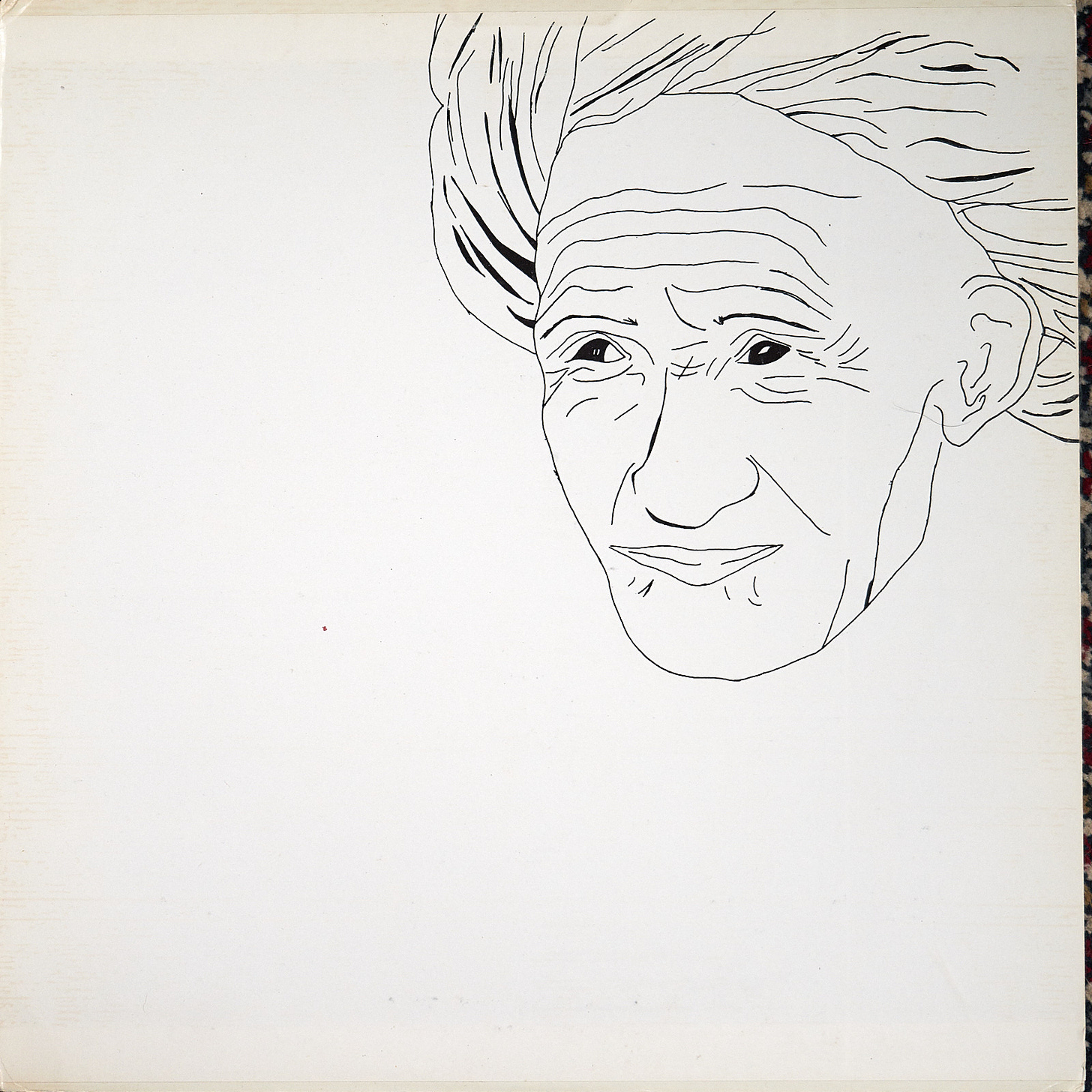The famous music writer Stephen Davis remarked
There are many recordings, made from 1968 to 2010, of ensembles calling themselves The Master Musicians [“Malimin"] of Jajouka. For me, only three stand out. First, Brian Jones Presents the Pipes of Pan at Joujouka (Rolling Stones Records, 1971). Second, The Master Musicians of Jajouka (Adelphi Records, 1975), recorded by Joel Rubiner, mostly in 1972, just before Ornette Coleman’s recording session in the village. Third (and perhaps most important) is Tribe Ahl Serif: Master Musicians of Jajouka (Musical Heritage Society, circa 1976). This is a two-record set made by Arnold Stahl around 1971, when a Danish film crew was working in the village. The second record in this set consists of about 25 minutes of the Boujeloudiya, or music for the goat god Bou Jeloud, which formerly danced in the village during the Aid el Kebir festival. The recording quality is excellent, and it features the large formation – 20 rhaitas and about 15 drummers – that Brian Jones recorded, and that I later chronicled beginning in 1973.
I bought a copy via Discogs and made a digital transfer so we can all listen to this long out-of-print 2xLP. I also made hi-res images and OCRed the sleeve notes for you.
Also on Youtube but without sleeve nones
About the rip
This digital file’s timings
1-1: Two Flutes - 0:00.000
1-2: Small ensemble: Flutes, Drums, Violin - 4:07.000
1-3: Gimbri - 10:35.036
2: Festival, Part I - 14:12.237
3-1: Flutes and Drums - 36:50.418
3-2: Violin - 40:50.133
3-3: Gimbri - 47:36.217
4: Festival, Part II - 54:45.432
Ripped from the 2xLP 2022-02-13 by Tom Worster. Dual CS 5000 + Ortofon Blue → Musical Fidelity M3si → MOTU M4 @ 44.1k/24 → Reaper → Export for Substack: 320kbps MP3 (LAME) / Export for Youtube: WEBM/320kbps VORBIS.
Front cover
the musical heritage society inc.
STEREO
MHS 3292/93
TRIBE AHL SERIF: MASTER MUSICIANS OF JAJOUKA
Recorded on location by Arnold Stahl
Gate-fold inside left
MHS 3292/93
TRIBE AHL SERIF: MASTER MUSICIANS OF JAJOUKA
Side 1:
1. Two Flutes
Traditional Arabic melodies recorded on the moun-tainside, played by Fandal, the chief musician, Muhammed, the chief flute maker. The two musi-cians solo alternatively using the secret technique of circular breathing in the constant flute note, playing and improvising continuously without pause for breath.
2. Small ensemble: Flutes, Drums, Violin
Recorded at night indoors after the evening meal. After tea and a smoke, about eight of the musi-cians, one after another, began to pick up their instruments and spontaneously get into a jam with singing and dancing.
3. Gimbri
The gimbri is a three-stringed instrument. Made from local wood and skins of animals, it is vaguely similar to a guitar (or bass) and can be found in most villages throughout Northern Africa. This recording of another traditional melody was done outdoors in the shade of the small music school built by the Master Musicians with the aid of author Brion Gysin.
Side 2:
Festival, Part I
This recording begins in late afternoon (Part I) and concludes on Side 4 with Part II recorded late in the evening. The festival, in honor of the King and the Caid, took place on the broad grassy summit of Jajouka. The full ensemble of musicians was present (about 30 now) as well as all the villagers and the Caid. The music begins with a long slow processional, "the kaimonos," followed by the trumpeting of the "rhaitas" in a long note in tribute to the patron saint, Sidi Hamid Sherk. From this into a short military-style tribute to the King and Caid. Then drums and rhaitas work into their own thing. The musicians begin to get it on, building and building, changing rhythms. The Caid leaves and the party goes on and on into the intense frenzy of Bou Jeloud music.
Side 3:
1. Flutes and Drums
Traditional tribal melodies and rhythms. Bamboo flutes led by Muhammed, the chief flute maker, and some of the older flautists. Drums led by Berduz, the tribe's chief drummer and energist.
2. Violin
Arab melodies played on violin by Tahir, "the clean one." Tahir is also the chief tea-maker; no one else may make tea for the musicians. At the time of this recording, Tahir is 21 years old, and plays each of the tribe's instruments. He sits cross-legged on a mat with the base of the violin on his knee playing the instrument with a bow, cello-style.
3. Gimbri
This selection of Arab melodies again played on the gimbri is performed by Fandal, chief musician. The music is romantic and one can feel, as well as hear, the Moorish-Berber influences and nuances found in jazz and rock music today.
Side 4:
Festival, Part II
Musicians and music lovers in many quarters of the world have become increasingly aware of and influenced by the diversity of the native musical folklore of Morocco. Years ago, the music of the various musical brotherhoods scattered throughout the beautiful Moroccan countryside was known mainly to collectors, cultists, devotees of trance music, some expatriate jazz musicians, and occasional travelers. But music tastes constantly change. As an in-stance, more and more music lovers as well as tourists flock each year to the annual Moroccan Folklore Festival in Marrakech. One Moroccan music group, the G'naoua, toured the United States a few years ago. Others, like the Jilala, Hadaoua, Aissaoua, and Hamadcha are no longer unknown to the west.
This album is about another relatively obscure, but highly influential group of musicians of aristocratic heri-tage: the Ahl Serif tribe — also know as the Master Musicians of Jajouka.
The village of Jajouka is a small, high place in the western portion of Morocco's Rif mountains. Access to it is up a long, winding, rock-strewn dirt road. Don't look for it on any map. Here, the Ahl Serif tribe, or Master Musicians of Jajouka, and their ancestors have been making music for centuries. About 800 A.D., Sidi (Saint) Hamid Sherk brought Islam to this region. His remains are buried in a sacred tomb at Jajouka, thus adding more power, authority and mysticism to the music of these people. Each day, with the morning sun, the musicians play a musical tribute to their patron saint and to Allah.
Descendants of Moors, Berbers and Arabs, the aristo-cratic heritage of the Master Musicians is evidenced in the papers they still retain given to their forefathers by the Alaovite Sultans who reigned in Morocco at the time of Charles II of England. The text of these documents gave the musicians extraordinary rights over the Sultan; such as the right to play him to sleep, to play for him as he went to the mosque on Friday, and, among others, the right to live in the palace.
Today, there are no Sultans, and the Master Musicians of Jajouka survive solely from their music. They receive a kind of tithe from surrounding villagers whom they play to as the workers harvest wheat each season. Despite the fact that the Master Musicians have done albums with the late Brian Jones of the Rolling Stones, and with Ornette Coleman, and have been written about by such writers as William Burroughs, Paul Bowles, Brion Gysin and Allan Ginsberg, they've received little, if any, monetary benefits. There has been some progress, though, in ad-vancing and promoting the music of the Ahl Serif, chiefly through their advisor and fellow tribesman Mohammed Hamri, a well-known Moroccan artist. Still, some younger musicians are forced to leave the village and seek paying jobs in large cities where the tourists visit. This is tragic indeed, as only the son of a Master Musician can receive the secrets of the esoteric rhythms and melodies of his ancestors and pass them on to his children.
The musicians live a simple, communal life on the hillside. They make their own instruments with a precision unique in this technological age. Their drums and three-stringed gimbris are made of wood and from the skins of animals. The flutes are carved from local bamboo shoots, and the shrill-sounding oboe-shaped rhaitas (named after the Datura flower usually used in combination with Kif, the cannabis sativa plant of Northern Africa) is expertly crafted from a hard wood similar to rosewood.
In Jajouka, one sleeps through most of the day's heat. You breakfast on goat-cheese and honey spread on freshly baked natural bread. The Musicians loll about sipping the ritual mint tea, smoking their kif pipes (sebsis) and playing their flutes. At night, blue kif smoke drifts over Jajouka down across the Jebel.
Although the Ahl Serif are essentially Moslem, they have another patron. He is called "Bou Jeloud" — Father of Skins, Father of Love, Father of Fear. He is Pan, the ancient little Goat God with his pipes and cloven hooves. The rites of Pan survive in the Moroccan hills in the form of Bou Jeloud, a young boy chosen, stripped naked in a cave, sewn into the bloody skin of a freshly killed goat, and masked with an old straw hat tied over his head and face. He is also the Father of Flocks, the shepherd who tends the goats in the hills. Bou Jeloud is taboo as long as he remains. Women flee from his presence. When he dances, he and the earth vibrate, and all around feel his great mystical powers.
I've related to you only some facts about the Master Musicians of Jajouka; the music speaks for itself. In the flute and rhaita passages on each side, you may notice that the musicians play without pause for breath. They use a technique of circular breathing (in the Sufi way, and similar to Rassan Roland Kirk) the secret of which has been passed on to them by their forefathers.
All the music on this album was recorded live on location as part of the sound track to a film. It's all here, from classic and traditional to counterpoint to multiple rhythms to the intense frenzy of Bou Jeloud music. Get into it and be moved. The pipes of Pan are alive.
HAJI-ARNOLD STAHL
Timings:
Side 1: 4:01 - 6:23 - 3:31
Side 2: 22:27
Side 3: 3:54 - 6:41 - 6:58
Side 4: 23:24
the musical hurtage society inc.
1991 BROADWAY, NEW YORK, N. Y. 10023
Recorded on location by Arnold Stahl
Illustrations: Lynnanne Johnson
Library of Congress Catalog Card No. 75-750879










TRIBE AHL SERIF: MASTER MUSICIANS OF JAJOUKA